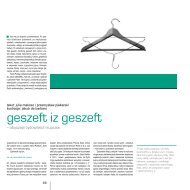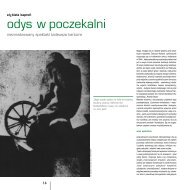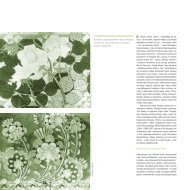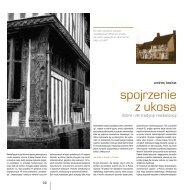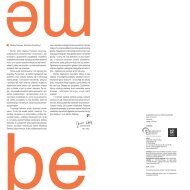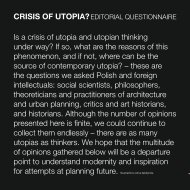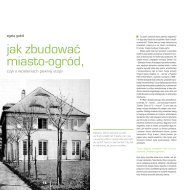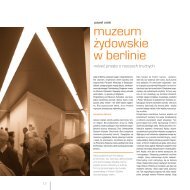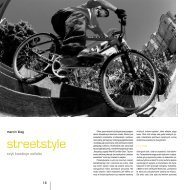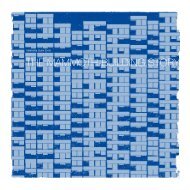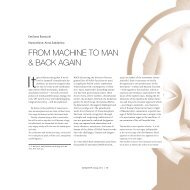ColleCtive luxury: - Autoportret
ColleCtive luxury: - Autoportret
ColleCtive luxury: - Autoportret
Create successful ePaper yourself
Turn your PDF publications into a flip-book with our unique Google optimized e-Paper software.
Łukasz Stanek<br />
<strong>ColleCtive</strong> <strong>luxury</strong>:<br />
Architecture and Populism in Charles Fourier<br />
In<br />
1972 Marxist philosopher,<br />
sociologist and the author of<br />
production of space theory,<br />
Henri Lefebvre published an<br />
introduction to the volume Actualité de Fourier,<br />
which followed a colloquium marking<br />
the 200 years of Charles Fourier’s birth (1772<br />
- 1837). 1 This rediscovery of a socialist writer<br />
dubbed by his political opponents “utopian”<br />
was inscribed into a broad rethinking of the<br />
relationship between architecture, city and<br />
politics since the late 1960s France. This rethinking<br />
was possible only by fundamentally<br />
challenging the relationship between production<br />
and consumption and by redefining<br />
the concept of work in the postwar Fordism.<br />
Lefebvre’s discovery of Fourier coincided<br />
with the formulation of his theory of production<br />
of space which was published in six<br />
books between 1968 (Right to the City) and 1974<br />
(The Production of Space). Developing a theory<br />
1 See: H. Lefebvre, ed., Actualité de Fourier: colloque d’Arc-et-<br />
Senans (Paris: Éditions Anthropos, 1975.)<br />
of space as produced and productive in social<br />
practices, Lefebvre argued that the central<br />
idea of Fourier was the conviction that new<br />
social relations required production of new<br />
spaces. 2<br />
Developing a critique of the post-war urbanism<br />
3 , Lefebvre noticed that the paradigmatic<br />
place for Fourier’s project of new space for<br />
a new society was the Palais-Royal, a space<br />
built for bliss, “space leading the discourse,<br />
stimulating pleasures, relating one to others<br />
and letting them reinforce each other”;<br />
a space of bad reputation hated by all moralists,<br />
both revolutionary and conservative.<br />
4 In a television interview of 1972 Lefebvre<br />
argued that the Palais Royal, being a place<br />
2 Lefebvre, introduction to Actualité de Fourier, p. 14.<br />
3 See: H. Lefebvre, Les nouveaux ensembles urbains (un cas<br />
concret: Lacq-Mourenx et les problèmes urbain de la nouvelle<br />
classe ouvrière), “ La Revue française de sociologie” 1960,<br />
nr. 1-2, s, 186-201; idem, Utopie éxperimentale: Pour un nouvel<br />
urbanisme, “La Revue française de sociologie” 1961, nr 2,<br />
s. 191-198.<br />
4 Un certain regard: Charles Fourier, broadcasted on Canal<br />
1, 06.09.1972.<br />
Henri Lefebvre interviewed about Charles Fourier in<br />
the Palais Royal, Paris, 1972<br />
of theater, gallery, encounter, commerce,<br />
work, leisure and <strong>luxury</strong>, was the inspiration<br />
for the phalanstery – a building for<br />
1620 inhabitants envisaged by Fourier as<br />
the crucial node for the society to come 5 .<br />
Fourier was conceiving an architecture<br />
as a collective <strong>luxury</strong>, conveyed by his<br />
description of the phalanstery as the “palace”<br />
which, in Silberling’s Dictionnaire de<br />
sociologie phalanstérienne (1911) was described<br />
as a place liberty is guaranteed “under the<br />
5 Ibidem.
auspices of good morals and observation of<br />
etiquette, courtesy and taste which naturally<br />
result from social life.” 6 In Lefebvre’s<br />
reading, Fourier opposed a century of<br />
ascetism in leftists thought and conceived<br />
collective <strong>luxury</strong> as a political project.<br />
“These ideas–wrote Fourier–which appear<br />
as a calculation of <strong>luxury</strong> and superfluity,<br />
are, in fact, a theory of high politics, from<br />
which will be derived the fundamental<br />
principle of social happiness, the germ of<br />
association.” 7<br />
Lefebvre’s reading of Fourier avoids the<br />
gap between architecture and the city,<br />
which characterized much of the reception<br />
of Fourier’s work, too often read either<br />
through the design of the phalanstery,<br />
considered a rural settlement or a center<br />
of a small industrial town; 8 or through the<br />
urban designs of Fourier’s “disciples.” They<br />
6 E. Silberling, Dictionnaire de sociologie phalanstérienne:<br />
guide des oeuvres complètes de Charles Fourier (Paris: Librairie<br />
des Sciences Politiques et Sociales, 1911), p. 326.<br />
7 Ch. Fourier, Des modifications à introduire dans<br />
l’architecture des villes (Paris: Librairie Phalanstérienne,<br />
1849), p. 20.<br />
8 According to Riasanovsky, Fourier neglected the<br />
world outside the phalanx, he delighted in rural life,<br />
and he offered “no counterbalancing enthusiasm<br />
for or interest in industry, urban life, technology, or<br />
science”. However, Jonathan Beecher, Fouriers biographer,<br />
corrected this view that Fourier was attracted<br />
to urban architecture and in the 1790s has formulated<br />
some general principles concerning the ideal urban<br />
center. Fourier’s writings about the city, although not<br />
extensive, established a broad approach to urbanism<br />
which inspired his disciplined to relate these principles<br />
to the planning of Paris. See: N. Papayanis, Planning<br />
Paris before Haussmann (Baltimore: Johns Hopkins<br />
University Press, 2004), p. 171.<br />
included the polytechnicien Victor Considerant,<br />
the anonymous urbanist known as<br />
Perreymond, and the architect César Daly;<br />
all contributors to the debates about the<br />
urban development of Paris in the 1830s<br />
and 1840s.<br />
This focus of Lefebvre on the “Fourierist<br />
city” was a symptom of a rethinking of the<br />
relationship between architecture and the<br />
city, inscribed into a general revision of<br />
the architectural avant-garde of the early<br />
20 th century and functionalist urbanism.<br />
In this context, the rediscovery of Fourier<br />
sounds paradoxical because of his essential<br />
role in the self-constructed genealogy<br />
of the avant-gardes and their performative<br />
historiographies. 9 This perception<br />
of Fourier was expressed, for example,<br />
in Walter Benjamin’s stress on Fourier’s<br />
discovery of glass in the Parisian arcades<br />
as a fundamental material for the architecture<br />
to come; in Tony Garnier’s project of<br />
the industrial city which refers to Fourier<br />
by a mediation of Emil Zola’s Work; or in<br />
Siegfried Giedion’s tracing the ideas of<br />
decentralisation in modern urbanism back<br />
to Fourier and developed by the postwar<br />
authors. 10 .<br />
9 P. Tournikiotis, The Historiography of Modern Architecture<br />
(Cambridge, Mass. : MIT Press, 1999).<br />
10 See: Tony Garnier, Une cité industrielle: étude pour la<br />
construction des villes (Paris: Vincent, 1917); Émile Zola,<br />
Work (London: Chatto & Windus, 1901 [1901]); Sigfried<br />
Giedion, Space, Time and Architecture: The Growth of a New<br />
Tradition (Cambridge, MA: Harvard University Press,<br />
1970), p. 820.<br />
autoportret 2 [34] 2011 | 37<br />
Lefebvre was pursuing a very different<br />
reading of Fourier to the one inscribed into<br />
the tradition of the architectural modern<br />
movement and its association with the<br />
Keynesian welfare state. The inspiration<br />
for such reading came from Roland Barthes,<br />
Lefebvre’s close friend, and his 1970<br />
book Sade Fourier Loyola. Barthes has shown<br />
all three - the libertine, the utopian socialist,<br />
and the founder of the Jesuit order - as<br />
logothetes, that is to say as founders of language.<br />
He noticed that what is specific for<br />
Fourier’s style is that he withholds the decisive<br />
utterance of the doctrine, giving only<br />
its examples, seductions, “appetizers”; “the<br />
message of this book is the announcement<br />
of a forthcoming message”; the signified<br />
of the book is stretching out of sight – it is<br />
the book’s future. 11 Fourier is an author of<br />
procrastination. Or, in the words of Walter<br />
Benajmin, “Fourier loves preambles, cisambles,<br />
transambles, postambles, introductions,<br />
extroductions, prologues, interludes,<br />
postludes, cismediants, mediants, transmediants,<br />
intermedes, notes, appendixes”. 12<br />
The same is true of Fourier’s architectural<br />
work: Fourier stresses that the buildings he<br />
describes are intermediary stages, which<br />
proliferate and multiply. They are essentially<br />
transitory objects, not unlike the<br />
“socialist objects” which Boris Arvatov, the<br />
Soviet theorist of constructivism produc-<br />
11 R. Barthes, Sade, Fourier, Loyola (Berkeley, University<br />
of California Press, 1976 [1970]), p. 90.<br />
12 W. Benjamin, The Arcades Project (Cambridge, Mass.:<br />
Belknap Press, 1999 [1982]), p. 642.
wikimedia<br />
wikimedia<br />
tivism, postulated to become “comrades”;<br />
and which were publicized by the “critical<br />
advertisements” by Aleksandr Rodchenko<br />
and Vladimir Mayakovsky linking the prerevolutionary<br />
visual habits with an imaginary<br />
of an post-revolutionary organization<br />
of consumption. 13 Thus, the phalanstery is<br />
preceded by tourbillon and a tribustery; and an<br />
experimental, or testing, phalanstery. These<br />
different buildings are associated with various<br />
stages of human development, including<br />
the period, called garantisme which imme-<br />
13 Ch. Kiaer, Imagine No Possessions: The Socialist Objects<br />
of Russian Constructivism (Cambridge, Mass.: MIT Press,<br />
2005).<br />
diately follows the period contemporary to<br />
Fourier, which he calls civilization, and which<br />
prepares next period, called the serialism. 14<br />
The garantisme is characterized by a series of<br />
institutions which guarantee solidarity and<br />
collaboration between the members of the<br />
society. Fourier writes that garantisme realizes<br />
the wishes and dreams of the civilization,<br />
but it did not manage to shed the kernel of<br />
evil – the nonassociated family, which will<br />
be resolved only in the serialism period. In<br />
that sense, garantisme is a reformist period,<br />
and architecture and urbanism can become<br />
tools for this reform: “A men of taste, a political<br />
architect, could transform civilization<br />
by a mere reform of architectural practice<br />
[…]”. 15 At the time when Manfredo Tafuri<br />
and other Marxist theoreticians argued the<br />
impossibility of architectural practise to<br />
change its role in the capitalist distribution<br />
of work, Lefebvre was reading Fourier in<br />
order to argue for a possibility of an “revolutionary<br />
reform” in which architecture was<br />
assigned an important role. 16<br />
14 Fourier, Des modifications, p. 7.<br />
15 Fourier, Des modifications, 17.<br />
16 L. Stanek, Henri Lefebvre on Space : Architecture, Urban<br />
Research and the Production of Theory, Minneapolis 2011.<br />
autoportret 2 [34] 2011 | 38<br />
A perspective view of Charles Fourier’s phalanstery,<br />
1834<br />
Below: a plan of phalanstery published in Le nouveau<br />
monde industriel, 1829<br />
Fourier drew a plan for an ideal city in the<br />
1820s and published in 1841 in a section of<br />
his Théorie de l’unité universelle and in 1849 in<br />
a pamphlet Cités ouvrières: Des modifications<br />
à introduire dans l’architecture des villes. 17 The<br />
city of Fourier was designed in four rings:<br />
the central city; the suburbs; the rural<br />
annexes; and the roads. These parts were<br />
distinguished by a gradation in ornamentation–a<br />
“<strong>luxury</strong>” aimed a collective pleasures–and<br />
by a differentiation in density<br />
and height. Every house was required to<br />
have a free ground around in order to<br />
prevent speculation and secure the circulation<br />
of air; the more central the house, the<br />
smaller the free area which, however, was<br />
not allowed to be smaller than the whole<br />
surface of the house. The distances between<br />
the houses were proscribed in a similarly<br />
gradual way. For the bourgeoisie one would<br />
build big houses for 20 – 30 families, differing<br />
in wealth. These structures would have<br />
common services and places for meeting<br />
connected by galleries which Benjamin<br />
argued to have been inspired by the first<br />
Parisian arcades.<br />
Many of these ideas were developed by the<br />
followers by Fourier: Victor Considerant,<br />
Perreymond and César Daly in their publications<br />
and in their contributions to the<br />
journal Revue générale de l’architecture et des<br />
travaux publics founded in 1839 and edited by<br />
Daly. Like the Saint-Simonians, the Fourier-<br />
17 Ch. Fourier, Oeuvres complètes, 5 vols (Paris: Anthropos,<br />
1971 [1846]).
ists stressed the importance of the railway<br />
system, supported public works as a means<br />
of development, and argued for a foundation<br />
of a new type of financial institutions<br />
necessary to finance the urban development,<br />
in that sense preparing the ground<br />
for Haussmann’s development of Paris under<br />
Napoleon III. These authors conceived<br />
a development of Paris focused on circulation<br />
of people, commodities and money;<br />
and the relationships between the vital<br />
urban center of public services, attractions,<br />
and the rest of the city. In that sense, the<br />
plans for Paris proposed by the Fourierists<br />
were inscribed in the new understanding<br />
of urban design developed since the late 18 th<br />
century in France which Michel Foucault<br />
in his lectures at the Collège de France in<br />
the late 1970s discussed with the term biopolitics:<br />
that is to say a series of techniques<br />
which exert control over the circulation of<br />
people, commodities, and capital according<br />
to an empirically identified statistical<br />
average rather than by a subjugation each<br />
subject to disciplinary measures. 18<br />
Foucault explained the emergence of the<br />
biopolitical regime by discussing late 18 th<br />
century urban designs such as the Rousseau<br />
plan of Nantes (1760). Perreymond’s<br />
projects for Paris published in 1842 and 1843<br />
in the Revue générale built upon this experi-<br />
18 M. Foucault, Security, Territory, Population: Lectures<br />
at the Collège de France, 1977–78 (Basingstoke: Palgrave<br />
Macmillan, 2007); M. Foucault, The Birth of Biopolitics:<br />
Lectures at the Collège de France, 1978–79 (Basingstoke:<br />
Palgrave Macmillan, 2008).<br />
The City of the 6 th Period (guaratisme) according<br />
Charles Fourier, 1822<br />
ence. The project depicts the center of<br />
the city but in fact it addresses the whole<br />
urban territory in order to tackle a series of<br />
problems, such as urban sprawl, economic<br />
development, hygiene, representation, and<br />
unemployment. The project of Perreymont<br />
introduces, basically, three decisions. Firstly,<br />
it unites the Île de Cité and the Île Saint<br />
Louis into an administrative and cultural<br />
center, giving it a public façade open to the<br />
new square which was envisaged over the<br />
filled southern arm of the Seine. Secondly,<br />
it introduces six arteries to connect this<br />
center with other parts of the city, the<br />
territory of the country and the overseas.<br />
The idea behind these arteries is, clearly,<br />
that of circulation and of flows, and this<br />
is best revealed in the way the monuments<br />
are treated, as objects which either modify<br />
the flows or which the flows swim round:<br />
a layout contrasting with the later geometry<br />
of Haussmannian Paris. Thirdly, the<br />
project suggested introducing a new market.<br />
Perreymond’s project changes the scale<br />
in which the city is imagined and designed,<br />
and this is best revealed when his project<br />
is juxtaposed with the de Laborde plan to<br />
which it was conceived as an alternative. 19<br />
In order to pass to this new scale of urban<br />
reality, new technologies of construction<br />
and transport were necessary, but also new<br />
modes of administration and new financial<br />
instruments, which conditioned Hausmann’s<br />
restructuration of Paris during the<br />
Second Empire. 20<br />
One of the essential aims of Perreymond’s<br />
project was to tackle unemployment by<br />
stimulating economic development. This<br />
theme was very much in the air in the<br />
debates in the 1840s Paris, and culminated<br />
in the February revolution of 1848 whose<br />
socialist postulates included the “right<br />
to work”. The centrality of work is the<br />
premise of Perreymond’s project, and the<br />
urbanist writes: “Work is the center of life.<br />
[…] Work is life, and life can only exist<br />
on conditions that it renew itself, that it<br />
propagate itself without ceasing, without<br />
19 Perreymond, “Études sur la ville de Paris,” Revue<br />
générale de l’architecture et des travaux publics 3<br />
(December 1842): cols. 540–4, 570–9; 4 (January 1843):<br />
vols 25–37; 4 (February 1843): 72–88; 4 (September 1843):<br />
cols. 413–29; 4 (October 1843): cols. 449–69; 4 (November<br />
1843): cols. 517–28.<br />
20 D. Harvey, Paris, Capital of Modernity (New York :<br />
Routledge, 2003).<br />
bibliotheque nationale, paris. reprodukowane za: bollerey,<br />
architekturkonzeptionen der utopischen sozialisten, s.101
evue générale de l’architecture et des travaux publics, 1843<br />
stopping”. 21 Perreymond argued that the<br />
first task of the society is to organize work<br />
and the system of work has a spatial counterpart<br />
in city which secures the circulatory<br />
network of work and capital. What is<br />
specific for his political position is the priority<br />
to socially useful work - for example<br />
of public work – as opposed to speculation.<br />
This question of work was essential for<br />
Lefebvre’s reading of Fourier. However, for<br />
Fourier, work can be thought as central<br />
for the society only if the concept of work<br />
is radically changed. That is to say, work<br />
should be understood by means of the<br />
concept of passion which is the foundation<br />
of Fourier’s general theory of association.<br />
Fascinated with Newton, Fourier conceived<br />
passion as the force of attraction between<br />
subjects, just like gravitation is the force of<br />
attraction between material objects. This<br />
concept transforms the character of work<br />
21 Perreymond, quoted in Papayanis, Planning Paris<br />
before Haussmann, p. 187.<br />
as based on passions and pleasure, and thus<br />
the difference between work and consumption<br />
becomes challenged.<br />
Fourier, he argued that rather than changing<br />
human nature, the thing which can<br />
make men happy is to base social order on<br />
the combinatorics of man’s passions and<br />
desires:<br />
“I am the only reformer who has rallied round<br />
human nature by accepting it as it is and devising<br />
the means of utilizing it with all the defects<br />
which are inseparable from man. All the sophists<br />
who pretend to change men are working in<br />
denial of man, and what is more, in denial of God<br />
since they want to change or stifle the passions<br />
which God has bestowed on us as our fundamental<br />
drives…” 22<br />
22 Fourier, quoted in Frank E. Manuel, The Prophets of<br />
Paris (Cambridge Mass.: Harvard Univ. Press, 1962), p.<br />
207.<br />
autoportret 2 [34] 2011 | 40<br />
Proposal of the development of the center of Paris<br />
by the Fourierist urbanist known as Perreymond.<br />
Published in Revue Générale de l’Architecture et des<br />
Travaux Publics, 1843<br />
Thus, Fourier’s critique of civilization and<br />
of capitalism was based on the fact that<br />
they restrain the fulfillment of passions<br />
of man by producing indigence, competition,<br />
boredom, deceit, adultery. At the core<br />
of his thinking lie the twelve passions of<br />
men, which are his fundamental instinctive<br />
drives. Fourier distinguished between<br />
the luxurious passions (desires of the five<br />
senses); the four group passions (respect,<br />
friendship, love, and parenthood); and the<br />
three serial passions – the passion to make<br />
arrangements, concordant or compromise;<br />
the passion to intrigue; and the passion to<br />
variety.<br />
Fourier stressed that the main principle<br />
for achieving pleasure was to combine<br />
passions. This is also the main principle<br />
of his urbanism: he writes that to isolate<br />
the passions and operate separately with<br />
them will fail in respect to each of them. 23<br />
He argues that the architects should not<br />
simply take care of the utility because “one<br />
occupied only by the utility does achieve<br />
neither the useful nor the pleasant”. And<br />
he adds: “to search for them in isolation is<br />
to operate within the system of the civilization,<br />
while we have seen that the pleasant<br />
is in the twelve branches inseparable from<br />
utility”; in other words: “the complex is<br />
always true; the simple is always false”. 24<br />
These statements coincide with Lefebvre’s<br />
arguments against functionalist urbanism:<br />
23 Fourier, Des modifications, p. 23.<br />
24 Fourier, quoted in Manuel, The Prophets of Paris, 240.
to conceive the city in term of the useful,<br />
the needed, and the necessary rather than<br />
on the basis of the pleasant and passionate;<br />
and classify the needs aiming at satisfying<br />
them one after the other rather than<br />
focusing on the relationships between<br />
them – this was the main point in Lefebvre’s<br />
writings in urban sociology since the<br />
late 1950s. 25<br />
Thus, Fourier argued that the “unitary architecture”<br />
was the productive relationship<br />
of all senses. He wrote that: “the senses<br />
are thus reliable guides for social progress”<br />
and argued that one should think progress<br />
as a product of sensual pleasures which<br />
are composed, collective and integral and<br />
application to the mass of people. 26 For<br />
example – describing the common dinner<br />
rooms – Fourier shows how the sense of<br />
taste is composed (combined with spiritual<br />
pleasure of a conversation); collective<br />
(developed in the community of the tribe);<br />
and integral (embracing all branches and<br />
relations). The production of composed,<br />
collective and integral pleasure is thus the<br />
main aim of architecture. In other words,<br />
architecture is theorized as an art of association<br />
and putting together of senses,<br />
forms, bodies, and ideas.<br />
25 H. Lefebvre, “Les nouveaux ensembles urbains (un<br />
cas concret: Lacq–Mourenx et les problèmes urbains<br />
de la nouvelle classe ouvrière),” La Revue française<br />
de sociologie 1, no. 1–2 (1960): 186-201; Henri Lefebvre,<br />
“Utopie expérimentale: Pour un nouvel urbanisme,”<br />
Revue française de sociologie 2, no. 3 (1961): p. 191-198.<br />
26 Fourier, Des modifications, p. 38.<br />
This idea of architecture of association is<br />
the engine of Fourier’s vision of the phalanstery.<br />
The phalanstery was conceived as<br />
an assembly of dissimilar people; types and<br />
ages; and their novel combinations. As it<br />
was noticed by Roland Barthes, Fourier’s<br />
principle of combination was that of a formal<br />
and arbitrary correspondence; thus,<br />
an association is not a humanist principle<br />
(bringing together everyone with the same<br />
mania) but rather of contrast; neither was<br />
it a liberal principle which aims at “understanding”<br />
or “admitting” passions, but<br />
rather of their enjoyment. 27<br />
These comments make it clear that, when<br />
read in the early 1970s by Barthes and<br />
Lefebvre, both authors tracing the emergence<br />
of the post-war society of consumption,<br />
Fourier’s writings gained a new type<br />
of actuality. While for Benjamin the main<br />
metaphor of Fourier’s understanding of the<br />
society was the machine, for Barthes and<br />
Lefebvre this metaphor in Fourier’s texts<br />
was, clearly, information. And information<br />
was not only the paradigm for social development<br />
in the 1960s Western societies, but<br />
also, under the influence of structuralism,<br />
the dominant model for theorizing consumption.<br />
In the writings of Barthes and<br />
Jean Baudrillard, an object of consumption<br />
was theorized not as an answer to a need,<br />
but rather as a sign which obtains its meaning<br />
within a system of signs in a system of<br />
27 Barthes, Sade, Fourier, Loyola, p. 99.<br />
autoportret 2 [34] 2011 | 41<br />
differences. 28 This theorizing of consumption<br />
was strikingly similar to Fourier’s<br />
combinatorics of passions which bases on<br />
the differences between the people and activities<br />
involved. This was confirmed by the<br />
fact that the essential question of Fourier<br />
– and indeed one of the main reasons for<br />
his strategy of procrastination – was the<br />
problem essential to consumption, namely:<br />
how to prevent a boredom stemming from<br />
an excess of pleasures.<br />
This is why, introducing Actualité de Fourier,<br />
Lefebvre hesitates whether Fourier’s work<br />
is topical as a utopian socialist or a “dystopian”<br />
socialist; that is to say whether he<br />
is an author of a project of architecture<br />
of pleasure and spontaneity; or rather<br />
a prophet of the society of consumption<br />
and socialized worker. In this reading,<br />
Fourier’s work comes close to such projects<br />
as Archizoom’s No-Stop city, or Exodus by<br />
Rem Koolhaas and Elia Zenghelis: what<br />
decides, for Lefebvre, about the actuality in<br />
Fourier’s work in the cultural and political<br />
condition of the 1970s is a state of undecidability<br />
between utopia and dystopia.<br />
The text above is a revised version of an essay published originally<br />
in the "Hunch" magazine (No. 14, ed. Salomon Frausto, NAi<br />
Publishers / Berlage Institute, 2010).<br />
28 R. Barthes, The Fashion System (Berkeley: University<br />
of California Press, 1990 [1967]); J. Baudrillard, The<br />
System of Objects (London: Verso, 2005 [1968]).



